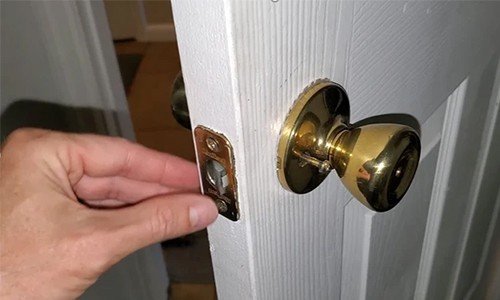
Think of a door knob like the wheels of a car. When you turn the wheel, everything should move smoothly. If you hear a click, it’s like that unsettling feeling when your car makes a weird noise. You know something might be off, but you’re not sure what it is. Let’s break down the reasons why your interior door knob might be clicking and how you can fix it without losing your mind.
Common Reasons for Clicking Door Knobs
When you hear a clicking sound from your door knob, it usually means something inside the mechanism isn’t working as it should. Here are some of the most common culprits:
- Worn-Out Springs: Over time, the springs inside your door knob can wear out. These springs help keep the knob engaged and allow it to latch properly. If they’re not functioning well, you’ll hear a click when you turn the knob.
- Misalignment: Sometimes, the door itself can shift or the latch may not line up correctly. When the latch is misaligned, it can cause a clicking sound as it struggles to engage.
- Foreign Objects: Occasionally, small debris can get lodged inside the mechanism. Dust, dirt, or even a stray piece of fabric can create friction that results in a clicking sound when the knob is turned.
How to Diagnose the Problem
Diagnosing the source of the clicking noise is the first step toward a solution. Honestly, it’s easier than it sounds. Follow these steps:
1. Inspect the Door Knob: Begin by closely examining the door knob. Look for any visible damage or wear. Is it loose? Can you see any gaps?
2. Listen Carefully: As you turn the knob, try to pinpoint where the clicking is coming from. Does it happen when you turn it slowly or quickly?
3. Check the Latch Alignment: Open the door and observe whether the latch lines up properly with the strike plate. If there’s a gap, you might need to adjust the door or the strike plate.
This simple inspection can reveal whether your issue is due to wear and tear, misalignment, or debris obstruction.
Fixing Worn-Out Springs
If you’ve determined that worn-out springs are the problem, don’t worry. Replacing them isn’t as complicated as it may seem.
1. Remove the Door Knob: Use a screwdriver to take off the door knob carefully. Pay attention to how everything is connected, just like taking notes in class.
2. Replace the Springs: Depending on your door knob type, you might find the springs easily accessible. If not, you may need to buy a replacement kit.
3. Reassemble the Knob: Once you’ve replaced the springs, reattach the door knob and ensure it’s functioning smoothly.
If you’re not comfortable doing this, consider calling a professional. It’s better to get it done right than to risk further damage.
Addressing Misalignment Issues
Misalignment can often be fixed without much hassle. Here’s how to go about it:
1. Adjust the Hinges: Sometimes, adjusting the door hinges can realign the door and the latch. Use a screwdriver to tighten the screws on the hinges.
2. Move the Strike Plate: If adjusting the hinges doesn’t work, you may need to reposition the strike plate. Loosen the screws and shift it slightly until the latch aligns correctly.
3. Test the Latch: After making adjustments, try closing the door and turning the knob. You should do this a few times to ensure it operates smoothly without clicking.
This often solves the problem without needing to replace the knob entirely.
Dealing with Foreign Objects or Debris
If you suspect something is lodged inside the mechanism, here’s how to clean it out:
1. Remove the Door Knob: Just like we did for the springs, take off the knob.
2. Clean the Mechanism: Use a can of compressed air to blow out any dust or debris. A gentle brush can help too.
3. Reassemble and Test: Once it’s clean, put everything back together and check if the clicking sound is gone.
Regular maintenance can help prevent this issue in the future!
When to Consult a Professional
If you’ve tried everything and still hear that annoying click, it might be time to call in a pro. Here’s why:
– Complex Issues: Sometimes, the problem might stem from the door frame or the entire locking mechanism, which can require specialized skills.
– Quality Concerns: If your door knob is old or of low quality, replacing it might be more cost-effective than repairing it.
You might be wondering how to find a reliable handyman. Ask friends for recommendations or check online reviews to ensure you’re hiring someone trustworthy.
Preventing Future Door Knob Issues
Once you’ve fixed the clicking sound, you might be wondering how to keep it from happening again. Here are some tips:
– Regular Maintenance: Check the knobs and latches periodically. Tighten screws and remove any dirt build-up.
– Lubricate the Mechanism: Use a silicone spray or graphite powder on the mechanism to keep everything running smoothly without creating a mess.
– Invest in Quality: Consider upgrading to a higher-quality door knob if you find yourself frequently repairing your current one.
A little care goes a long way in keeping your door knobs functional.
Hearing your interior door knob clicking when you open the door is a common issue that can usually be resolved with some basic troubleshooting. Whether it’s worn-out springs, misalignment, or the simple presence of dust and debris, understanding the cause can lead you to the right fix. Don’t hesitate to reach out to a professional if you’re feeling stuck; it’s always better to ask for help than to risk further damage. With a bit of care, you can keep your door knobs clicking smoothly—just not in a way that drives you crazy!